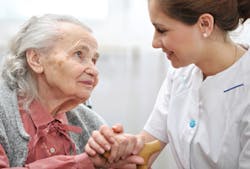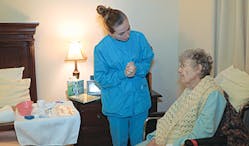How to develop an oral health educational program for health-care attendants in long-term care facilities
By Nancy C. Stannert, RDH, BS
The December 2012 statistics from the United States Census Bureau once again confirm what some call the "graying of America."1 The United States is a country with a significantly high percentage of people over age 65, and by the year 2060, this population is expected to more than double to 92 million.1 Contemporary medicine is a major contributing factor to the longevity of this population, but unfortunately, quantity of years lived does not necessarily equate to quality of life. Current trends indicate that many aged individuals will live their final years in some type of long-term care facility, which means that they might not have access to comprehensive oral health care.
The majority of hygiene care provided to residents of these facilities falls into the hands of geriatric nursing assistants, certified nursing assistants, and other health-care attendants.2 Oral hygiene care is normally a low priority for these caregivers due to the high demand of their time in other caregiving capacities, and most dependent residents cannot perform their own oral care, leaving the task of brushing to health-care assistants, who, according to recent studies, spend only 16.2 seconds per resident brushing teeth.3
Long-term care residents experience more dental and periodontal disease, which may lead to a decline in their quality of life and negatively impact their overall health, increasing their risk of masticatory disability and consequential weight loss or obesity, low self-esteem, and reduced social contact.6 Pain from untreated dental disease restricts the normal activities of daily life and disrupts sleep.6
In addition, poor oral health is linked to systemic disease, as well as to the risk of malnutrition, ischemic stroke, carotid atherosclerosis, reduced glycemic control in diabetes, and/or increased risk for aspiration pneumonia.2 Hospital-acquired infections, or nosocomial infections, are also common in long-term care facilities because of residents' reduced resistance to illness, and these bacterial and fungal infections can cause severe pneumonia.7 Improving the quality of the oral health care in long-term facilities is important because residents' risk for aspiration pneumonia – the leading cause of death from infection in long-term care residents – is compounded by periodontal disease, dental caries, and poor oral hygiene, while bacteria found in dental plaque is a causative agent in nosocomial infections.7,8
------------------------------------------------------------
Other articles to consider reading:
------------------------------------------------------------
Long-term care facilities are required by federal and state law to provide comprehensive dental care to their residents – including the cleaning of dentures and other removable prosthetic appliances, as well as the cleaning of the tongue and teeth if the resident is incapable of self-care.9 State surveyors conduct yearly inspections to ensure that the facilities meet the requirements established by the Health Care Financing Administration (HCFA), and long-term care facilities are subject to fines of up to $10,000 a day if they fail to comply. Medical charts for residents must include a comprehensive assessment and plan of care, including dental care.10
Not always, but more times than not, the dental care is deficient, despite these laws.3 Time constraints are the number one reason why adequate oral hygiene, twice a day, is nearly impossible.
Other challenges include care-resistive behaviors, access to oral hygiene supplies, fear of causing pain or injury, and additional assigned duties. Health-care attendants do not provide a comprehensive assessment of the oral cavity, and most refer to a nurse or opt out of trying to provide care when confronted with obstacles. Their practices for providing oral care often include brushing only; floss is generally not available, and most attendants aren't comfortable using it.
While most health-care attendants have a positive attitude regarding the importance of oral care, surveys of nursing home staff show that only a small percentage receive adequate training in oral health and the management of oral care for nursing home residents.7 Examples of deficiencies include not recognizing the relationship of sugary foods and drinks to the formation of dental caries and not understanding that soft debris is bacterial plaque.7
Residents of long-term care facilities are one of the most dentally underserved population groups in the country, which makes their caregivers an excellent target for oral health promotion programs.6 The Train-the-Trainer educational model can be useful for implementing an oral health promotion program in a long-term care facility. To start your own educational program at a long-term care facility, follow the steps below:
Train the Caregiver
Step 1 Assess the need for education.
By personally visiting long-term care facilities, hygienists can assess the need for education. Speak to the nursing supervisors, as well as the facility directors. Some supervisors may indicate that appropriate oral care is being provided, and others may discuss perceived deficiencies, but professionally determined need may differ from the perceived need of the nursing supervisors. To professionally determine the need for education, perform an oral inspection of a random sample of residents. Use simple dental indices – such as heavy food debris, plaque, gingival inflammation, and dental decay – to quantify the need for improved dental care.
Arrange a time to interview the health-care attendants individually in order to determine current practices for assessing and providing oral care and assess the oral health literacy of the direct care providers. Develop a list of eight to 10 questions used to assess oral health knowledge and daily patient care practices before deciding what information should be included in the program (see list of interview questions). Use open-ended questions and be creative with the inquiries to encourage communication.
Step 2 Identify the target audience.
Once the need has been established, identify the target audience. Usually, health-care attendants provide daily personal care for long-term care residents. In some facilities, however, certified or geriatric nursing assistants may be assigned to hygiene duties. Geriatric nursing assistants specialize in elder care and must pass the Geriatric Nursing Assistant certification exam.11
Assess the demographics of the target audience by determining the audience's highest level of formal education, reading comprehension level, primary language, and oral health literacy. The ombudsman at the local Department of Aging is an excellent resource for gathering demographics on the primary language, gender, age, and race of caregivers. Additionally, visiting the long-term care facility and meeting with the director of nursing will provide more specific demographic information about the caregivers.
Use these demographics to develop appropriate educational materials and instructional techniques for your target audience. Studies have shown that only 12% of the population is proficient in oral health literacy, so developing a user-friendly Train-the-Trainer model for a diverse target audience might be challenging.12 Adults with limited health literacy have less knowledge of health-promoting behaviors and disease management, so the training you provide should focus on improving oral health outcomes by including current, evidence-based oral health data in the long-term care setting. 12
Step 3 Choose the instructional media to be used.
Media formats may range from traditional materials such as slides, overheads, and charts to more advanced methods such as podcasts, CD-ROMs, DVDs, web-based independent learning modules, and interactive videos.4 Consider incorporating several different styles of visuals into the program to create a teaching tool that maximizes the command of essential information. Imaginative, eye-catching use of instructional media, such as creative video streaming inserts and video captures of hands-on demonstrations, often reinforces the critical content areas and hold the attention of the audience longer.13
The flash-based DVD format is the most efficient tool for maximizing time and the amount of critical information provided. This format enables the unconstrained delivery of information to anyone at any time as needed for teaching purposes.13 Ideally, a flash-based DVD will include a menu of oral health educational choices, which the caregiver can view as a single participant or with a group since some facilities may utilize the interactive media format when conducting new employee orientation sessions and/or for ongoing and continuous education for current employees. The menu may also include a pretest and a posttest to measure employees' comprehension of the material. This feature will enable long-term care facilities to provide data on the success of their employee education programs to accrediting bodies and organizations conducting facility assessments.
Ultimately, the goal of the Train-the-Trainer model is to teach accurate oral health practices and improve the oral health literacy of caregivers at an appropriate learning level. Regardless of the media format you choose, you should use media design features that help the caregivers to solidify their oral health knowledge, internalize the information provided, and take steps to improve oral health-care practices for their residents.4 To enhance the quality of the media, consider consulting an instructional designer, using professional photography and videography techniques, and scripting recording sessions.
Step 4 Determine the estimated length of the project.
The length of a presentation is critical to its success as a teaching tool. The needs of the facility and the input of the nursing supervisors regarding the length, features, and content of the presentation are essential during this planning phase. Other factors to consider are time constraints and the attention span of the viewers. In group settings, the attention span of the average adult is 20 minutes, so it's wise to break the presentation into shorter segments or learning modules. Breaking down the presentation will enable the audience to digest and internalize information, while also facilitating targeted module searches dependent on the training goals and type of care provider (for example, new or continuing employee) participating in the program.
Step 5 Identify information to be included in the project.
Once you've determined the length for your presentation, figure out what kind of information you'll include in the project. Here's a sample outline:
- Home: Purpose of the program
- Table of Contents/Menu
- Pretest Evaluation: 10 to 12 questions that measure the current oral health literacy level of health-care attendants.
- PowerPoint Presentation: Main educational component including video snippets
- Video Snippets:
Step 6 Implement the project.
Ideally, you should be present when the educational model is being viewed. This way, you can answer questions and help the audience to solidify their oral health knowledge and internalize the material. Afterward, follow up with regularly scheduled visits to the facility and frequent inquiries about the implementation of improved oral hygiene practices. Finally, continue to pursue evidence-based care and apply new information to the ever-progressing model.
Health-care attendants in long-term care facilities are the front-line oral care providers for dependent residents. Unfortunately, they exhibit the least knowledge about dental disease of all onsite health-care professionals. Using evidence-based education and effective training programs can help you to provide essential personnel with the knowledge and skills necessary to perform the daily oral health-care practices that are required in long-term care facilities. When daily oral hygiene and preventative education are employed, long-term health outcomes are likely to improve, and the risk for aspiration pneumonia and other nosocomial infections commonly occurring among dependent residents in long-term care facilities is reduced.
Interview Questions
- Where does digestion begin?
- What is plaque?
- What is gum disease?
- What is biofilm?
- Can bacteria in the mouth cause illness?
- Describe mouth care practices.
- Do you feel comfortable brushing and flossing teeth?
- Do you clean dentures and partial dentures daily?
- Are oral health supplies readily available and used?
- Are residents self-sufficient or dependent on caregivers for mouth care practices?
Nancy C. Stannert, RDH, BS, recently graduated from the dental hygiene degree completion program at the University of Maryland. For her final capstone project, she developed an oral health educational model for the purpose of training certified nursing assistant and geriatric nursing assistants in long-term care facilities. The model is in the form of a DVD, which at some point the author hopes will be distributed throughout Maryland. This article is a modified version of the paper associated with the capstone project .
Past RDH Issues







